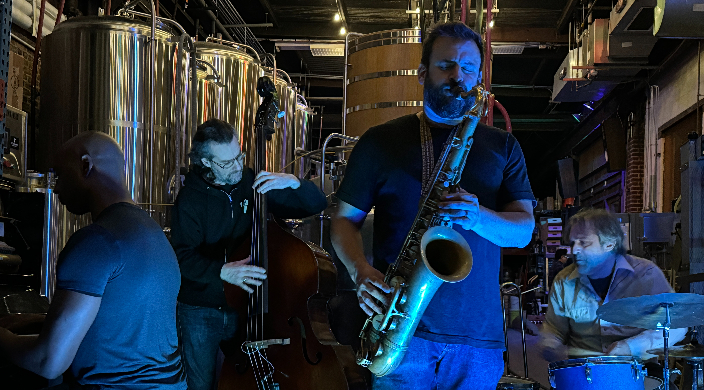
A reminder: You will find more interesting reading and commentary from Alan McLeod and Boak & Bailey. Particularly this week, when “other links” are condensed because were are traveling. And still finding time to support #pubjanuary, listening to jazz in Long Island City, being dazzled by the selection at The Grand Delancey in Manhattan, noticing how few women there were in the very crowded Other Half taproom by Rockefeller Center, and reconnecting with the fabulous frites at Bold Monk in Philadelphia.
I was working my way through The Legend of the Selmer Mark VI last week when How to Ship a Brewery Around the World hit my radar. It is a story about Pete Brown, a Boston native brewing in London, buying the Russian River brewing kit and shipping it to London for use at Forest Road Brewing.
Shipping breweries long distances, particularly new ones, is hardly unusual. Nor is the way Brown and his father disassembled and reassembled the kit. Nonetheless, I am a sucker for these stories. For instance, few mash tuns are as well traveled as the five hectoliter one sitting on display at New Belgium Brewing in Colorado. Jeff Lebesch and Kim Jordan won their first Great American Beer Festival medal with the mash tun (and adjoining equipment, of course). Before it returned to the brewery in the early aughts to become a museum piece, Gordon Knight won medals with it at three different breweries.
To ask if magic is in the equipment or in the brewer requires that you accept there is more to brewing than engineering. So you might want to stop right here if you think it is silly that Brown found himself thinking, “It would be our own fault if we couldn’t kick magical beer out of this thing. It’s like having Jimi Hendrix’s guitar; if we play it right, it’ll do the right thing.”
As is typical for a The New Yorker story, The Legend of the Selmer Mark VI (which is, if you didn’t know, a saxophone) is part personal journey, part history, part how-this-is-made, and part philosophical. Early on, the author writes, “I know that how you feel affects how you play, and that if I want to get closer to what I hear in my head I just need to practice. But, in my weaker moments, I’ve wondered about the magic horn. What sound might it grant me, if I got my hands on one?”
Should you wonder what it looks like, that’s a Mark VI in Chris Cuzme’s hands in the photo at the top. The Fifth Hammer co-founder started playing saxophone when he was eight years old, and he was a professional musician long before he became an amateur brewer who would turn pro. He still plays a few gigs, and every Wednesday he gets together with a rotating cast of long-time friends in the “Brewside Lounge,” where the front portion of the Fifth Hammer brewhouse becomes an intimate jazz room.
Cuzme was excited to talk about the Mark VI story, and not just because it is another chapter in a catalog of instruments he owns. During conversations across six years, he’s thoughtfully answered my questions related to where creating music and beer intersect, including how learning, collaborations and improvisation impact the process.
“I’ve always thought the parallel is you can’t just pick up an instrument and play what your are hearing,” he said last year. “You have to learn the process of making a sound . . . and then, ideally, you are adjusting it so that it is a language where, in your head, you have a note and essentially you go back to that note and you play it. It’s happening instinctually.
“The same is happening with brewing, I think. I want this flavor. I know how to get there through process and experience.”
After the Wednesday session ended, Cuzme talked with a friend, Sean Nowell, who also plays a Mark VI, and who occasionally joined the foursome (which at times during the evening became a sixsome). Deep in a discussion about reeds, Nowell turned to an outsider and said, “Sorry if this is getting geeky.” It was no more, or less, geeky than listening to Fifth Hammer head brewer Mark McGurrin talk about the balance between isoamyl acetate and 4-vinyl guaiacol in the hefeweizen Cuzme would drink before the session began.
Nowell told Cuzme that he could hear him playing inside the brewery doors as he approached the building. “It sounded like you,” he said. That’s not as simple as it, well, sounds. Rereading the traveling brew kit story, I decided the thought Chris Almeida closes his saxophone essay with fits nicely. “The sound is how you feel about yourself,” he wrote.
A brewing kit, an instrument, they matter . . . but if there is magic, they are only part of it.
FYI, at the top, that’s TW Sample, Nathan Peck and Mark Bordenet playing with Cuzme last Wednesday in the “No ballad zone.”
You might also enjoy
– Stop curating beer, start thinking beer. Roger Baylor at this best.
– Doug Veliky’s predictions for 2024. Yes to 12-ounce pours.
– Reflections on Erika Goedrich and the Craft Beer Cellar. In particular, read what Bill Butcher at Port City has to say about the power of an individual to drive change.
– Six things I’d like to see in South African craft beer in 2024. No to beers you end up watering your plants with.
– How Iowa’s Big Grove Brewery Defies the Odds. But well aware of the “New Glarus Effect.”
– What To Do About Beer Festivals. Set aside some time. This occupied a good chunk of a train ride from Manhattan to Philadelphia.
– E-Nose Sniffs Out Coffee Varieties Nearly Perfectly. There must be a related beer (or hops) application.